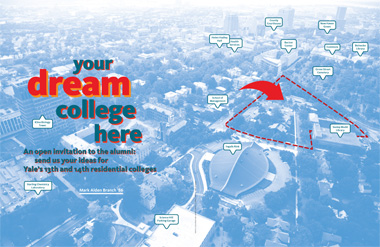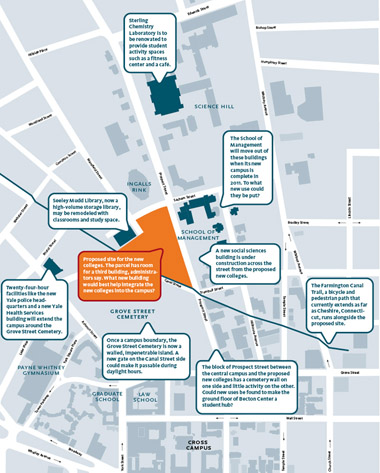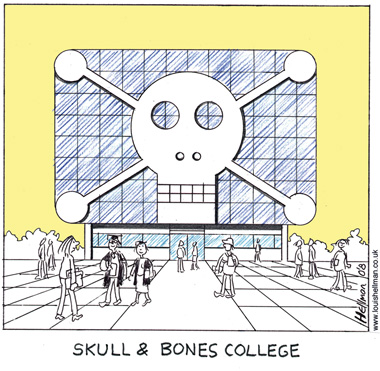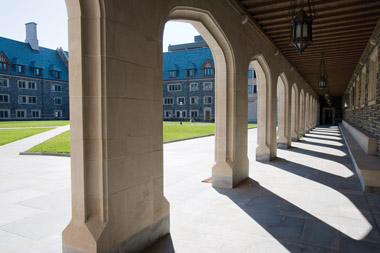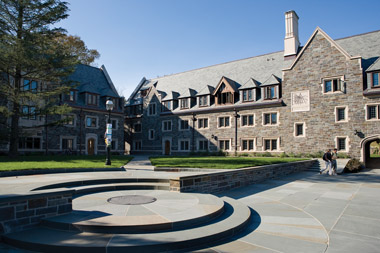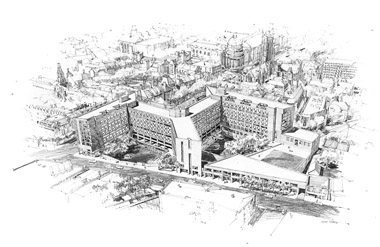
 |
||
The Yale Alumni Magazine is owned and operated by Yale Alumni Publications, Inc., a nonprofit corporation independent of Yale University. The content of the magazine and its website is the responsibility of the editors and does not necessarily reflect the views of Yale or its officers. |
|
Your Dream College Here What if you had the chance to build a new Yale residential college from the ground up? What would it look like? Would you do anything new and different—things never before seen at Yale? What amenities, what special features would you include? Until recently, all such questions were strictly hypothetical. But the university now appears headed toward expanding Yale College’s enrollment and building two new residential colleges (see Light & Verity, January/February). Yale’s board of trustees, the Yale Corporation, has not yet approved the plan, but they are to vote in June on whether to proceed with the colleges (and they are widely expected to say yes). So it’s never too early to start sending in your ideas about the shape these new colleges might take. Last year, when President Rick Levin first broached the idea to the Corporation and appointed committees to consider an expansion, we asked you to suggest names for the new colleges. (See “Name Those Colleges” for the complete list of suggestions, from Nathan Hale to Emily Dickinson.) This time, we’re calling on all alumni to consider the design of the colleges. For instance: what architectural style would look right? Should the rooms be arranged in suites, singles, or something entirely different? What kinds of activity spaces will attract the twenty-first-century college student? If you were an undergraduate at Yale: what did you like about your residential college? What did you dislike? If you were a graduate or professional student at Yale: what could Yale learn from the college you attended? And should the colleges find ways to involve more graduate and professional students? Should the professional schools pair up with sibling colleges, for example? Give them what they want? To get you started, we asked a number of people well acquainted with Yale, its architecture, and the residential college system to imagine what the new colleges might be. The most common idea to emerge was that they shouldn’t be drastically different from the existing colleges. The system, after all, presumes a rough equity among the colleges, and most agree that the system works. “For the most part we know what in the residential college system works well,” says Laura Cruickshank, the university planner, who has overseen the renovation of some existing colleges. Cruickshank wouldn’t speculate on the new colleges before their approval, but with regard to the renovations, she says: “We know that the system of suites, the way of eating together, the common room, those kinds of basics are accepted in a widespread kind of way, and I don’t think we'd vary from that.” To be sure, building colleges that are more of the same would flout trends in college housing elsewhere. Some universities now provide housing for students with similar interests or backgrounds: Cornell and Dartmouth offer accommodations organized around race and ethnicity, and many schools have ecologically themed, international, or drug- and alcohol-free housing. Similarly, since the proposed site for Yale’s new colleges is near Science Hill, what if they were geared toward students with a passion for science? And while Yale’s existing colleges are built around three meals a day in a refectory-style dining hall, many colleges elsewhere are adapting to the vagaries of adolescent eating habits with more flexible, food court-type settings and longer hours of operation. But Jane Wright, an architect who has designed residential colleges at Baylor, Tulane, and the University of Monterrey, says universities should resist focusing on those kinds of “market pressures” from students. Wright’s firm, Hanbury Evans Wright Vlattas & Company, is currently working on two additions to the college system at Rice. “We studied the colleges at Rice, and some of the ones that were built later are less successful community spaces—because they have responded so highly to what the students said they wanted: a high degree of privacy, for example. And so students living in those colleges today, when interviewed or surveyed, would tell you that they felt less of a sense of community than their colleagues in more shared-space colleges.” From squash courts to barbecue pits? The original Yale residential colleges, built in the early 1930s, set the U.S. standard for the kinds of public spaces and amenities that define a college community: a dining hall, a generous common room, a lounge for the college’s fellows, and a library. They also typically had squash courts and perhaps room for a printing press or music practice rooms in the basement. The student rooms themselves followed an old Yale pattern: three-room suites housing two students each. After World War II, Yale admitted considerably more students, and bunk beds were soon installed in many suites so that suites designed for two students could house four. When Ezra Stiles and Morse colleges were built to address the overcrowding, students begged for more privacy. As a result, those two colleges have plenty of singles, but no real suites. And as coeducation brought another expansion of enrollment, the bunk beds came to Stiles and Morse, too. Beginning in the 1990s, Yale addressed this overcrowding—along with building code problems and generations of deterioration of the buildings—with an enormous and expensive renovation campaign. (Eight of the twelve existing colleges have been renovated, with Jonathan Edwards under way and Morse, Stiles, and Calhoun still to come.) Student suites have been combined and reorganized to eliminate stacked beds, and new suites have been added where possible. The basements of the existing colleges have been transformed along the way. The squash courts have been converted to theaters or basketball courts, and other amenities, fit for luxury resorts or artists' retreats, have blossomed: fitness rooms (every renovated college has one), dance studios, game rooms, printing presses, recording studios, and darkrooms. Every college has a different array of such features, depending on student input and on what Cruickshank calls the “personality” of each college. But if we’re building colleges that don’t yet have personalities, could we think more creatively? Would the students of today prefer chamber music spaces and HDTV cinema halls? Or should the features be more outre—video arcades, perhaps, or all-night cafes with grill-your-own barbecue pits? Magdalen College at Oxford has its own deer park, but the Prospect Street site isn’t quite that big. Gothic? Georgian? None of the above? One of the most important questions will be one of aesthetics. Should the new colleges look like their older siblings? If so, how much? Or should they look like the architecture of today? School of Architecture dean Robert A. M. Stern '65MArch believes that a few avant-garde buildings on campus help “pepper the stew,” but he says residential colleges are no place to experiment. “There are places to push the envelope, but not the residential colleges, especially if we want to make the students and the faculty associated with them feel that they are not in 'suburban' Yale but in Yale,” says Stern. “They have to look like Yale colleges.” But how does one capture the essence of a Yale college? Does it mean trying to imitate a Branford or Berkeley, which themselves are imitations of centuries-old colleges at Oxford and Cambridge? Princeton, which is in the process of building a college system of its own, recently completed a straight-forwardly Gothic college, borrowing materials and idioms from its own traditional campus architecture. Stern praises Princeton’s effort, but he also says that Yaleness can be created in a less imitative way. “In Morse and Stiles, Saarinen worked very hard to make two buildings that related to the historic Gothic colleges—towers, courtyards, entryways, the street between them,” says Stern. “He knew what he was doing.” The problem was in the colleges' budget, Stern says: “There was not enough money to really do it right.” (Indeed, many denizens of Morse and Stiles over the years have felt that they were consigned to “suburban” Yale.) How far is too far? Finally, the university will have to consider the implications of the proposed site of the colleges. In public forums last fall, students voiced their concern that the new colleges—separated from the center of campus by the Grove Street Cemetery—will feel remote and isolated. Administrators countered that the site is adjacent to an important, if underserved, part of campus—Science Hill—and that the new colleges would be part of a long-term planning effort to enliven the northern part of the campus. Other pieces of the plan include the recently built police headquarters and the planned home for University Health Services (both on Lock Street west of the proposed colleges’ site), a remodeling of Seeley Mudd Library to provide more study or classroom space, and a renovation of Sterling Chemistry Laboratory with student activity spaces such as a fitness center or café. Administrators also point out that the site for the colleges has room for a third building. What sort of building would attract the most and best kind of student traffic to the area? Yale’s planners will likely be tackling such questions in the coming months. But let’s give them some help. Write to us at alumnimag@yale.edu with your ideas about the new colleges—and the residential college system in general. We’ll keep the conversation going. |
Related Name those colleges! Trustees move toward approval of two new colleges Yale moves toward college expansion |
“What this place really needs… ” Advice for the planners of Yale’s next colleges: |
“I would love to have a café in the college that has the same kind of ambience as the Bass Library café: lots of little tables and lounging space for students to hang out in. I would just add appropriately illuminated wall space to feature college student art/photography and maybe a little corner stage area for small performances or an open-mike setup.” |
“[Sharing activity spaces] seems like an excellent way to pool resources to get even better facilities. At the same time, the new colleges should not be carbon copies of each other. Students want to have pride in the unique natures of their colleges. Students in Morse and Stiles are very proud of the ways in which each differs from the other.” |
“You could incorporate retail into the site. What if a Whole Foods was part of the development of the new colleges? That would bring a lot more activity to the area and make them seem less remote.” |
“One of the things I think is most important is to have the college offices in a high-traffic area. If they’re tucked away, that prevents the serendipitous encounters that are so beneficial in a residential college setting. Also, Oxford and Cambridge used to have working gardens that helped provide the food for the colleges. I would certainly build a working garden into any new college. Finally, I don’t think either Yale or Harvard has taken care of its arts and sciences graduate students very well, so I think there ought to be a lot of consideration as to how they might be incorporated as the college system expands.” |
|
|
|
|
|
|
|
|
©1992–2012, Yale Alumni Publications, Inc. All rights reserved. Yale Alumni Magazine, P.O. Box 1905, New Haven, CT 06509-1905, USA. yam@yale.edu |
||
